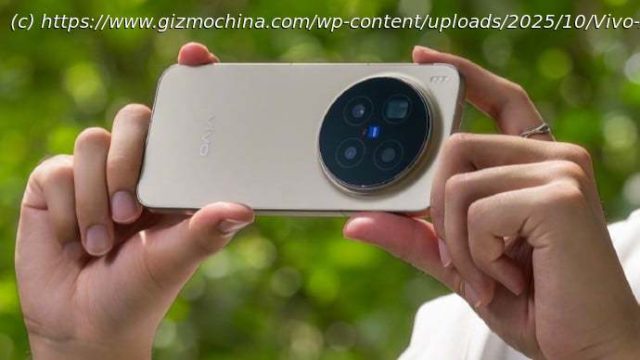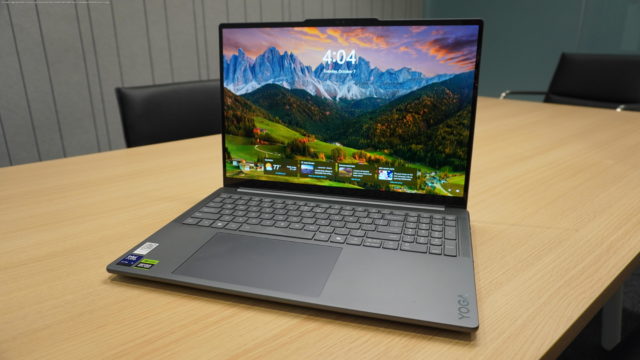With a drop-dead gorgeous tandem OLED and powerful hardware, the Yoga Pro 9i Aura Edition is a high-performance device, but it’s hungry for power.
Lenovo Yoga Pro 9i Aura Edition
Lenovo’s Yoga Pro 9i Aura Edition is available now for $1,949.
It’s got a gorgeous tandem OLED display, with a thin form and great performance across multiple use cases.
It has middling battery life and noisy fans.
Dell Inspiron 16 Plus 7640 Intel Ultra 9 512GB SSD 16GB RAM 16-inch 2.5K Laptop:
$800 (save $300)
Lenovo ThinkPad E16 Gen 2 Ryzen 7 1TB SSD 16GB RAM 16-inch Touch Laptop:
$959 (save $280)
HP OmniBook X Flip Intel Ultra 7 1TB SSD 16GB RAM 14-inch 2K 2-in-1 Laptop:
$800 (save $350)
Dell Inspiron 16 5645 Ryzen 7 1TB SSD 16GB RAM 16-inch Laptop:
$630 (save $170)
HP OmniBook X Ngai Intel Ultra 7 512GB SSD 16GB RAM 17.3-inch Touch Laptop:
$750 (save $500)
The Yoga Pro 9i (16-inch) is truly a gorgeous laptop, and it all centers around its display. It’s the first thing you notice when you look at it, and it holds your gaze.
It’s got something unique: it’s one of the few new Windows laptops with a tandem OLED, resulting in a crisp, exceptional image that’s smooth as silk and exceedingly bright (up to 1,000 nits).
Even though I’ve had a chance to see the 3.2K tandem OLED in person, the model I took home with me had the slightly less impressive (but still very good) 2.8K OLED with the Nvidia GeForce RTX 5050 GPU. Yes, when up against the tandem OLED running the RTX 5060, it isn’t quite as vibrant, but all things considered, it’s a fantastic display with the same 120Hz refresh rate, HDR 1000 True Black, 100% DCI-P3, and slick glass screen. Especially when compared to other devices in the same price bracket.Lenovo Yoga Pro 9i Aura Edition
The Yoga Pro 9i has a stunning tandem OLED display.
The Lenovo Yoga Pro 9i is a high-performance Windows laptop designed for professionals and creatives who also do some gaming. It comes with 32GB of LPDDR5X (soldered) RAM, and a 1TB M.2 PCIe Gen 4 SSD. I used it for a few weeks as my main driver and love how adaptable it is.
It’s a fantastic laptop for work, with the large, crisp OLED display, tactile, full-sized keyboard, and generous I/O. It makes a fantastic machine for creatives, with one of the most powerful CPUs on the market for ultraportables, the Intel Core Ultra 9 285H from the “Arrow Lake” series, running 16 cores.
And it’s a capable gaming machine, if not fully committed to the identity. The hardware carries for most titles, with immerse visuals powered by the Nvidia GeForce RTX 5050 or 5060 GPU. For long gaming sessions, however, other laptops in the price range are going to be more optimized for longevity and heat mitigation.
And it can certainly get warm. The fan kicks on frequently for short bursts, even while doing everyday tasks. Copying large files or multitasking with several browser tabs, for example is enough to pop it into gear, and at full speed it’s loud enough to hear from the other room. That said, the laptop itself doesn’t get uncomfortably hot to the touch.
Its physical form is very neutral, with Lenovo’s gray on gray on gray design that resists fingerprints but looks rather corporate. The full-sized keyboard is spacious and well-positioned, with an ample 1.5mm key travel and satisfying click. I just wish it had a haptic trackpad, as that would really seal the deal as a premium creative-first machine, especially when paired with the display.
There’s nothing wrong with the trackpad on the Yoga Pro 9i (although I do wish it were centered), but in 2025, but consumers want to see these kinds of premium touches round out the package when they’re paying over $2,000 on a laptop. At least as an optional upsell.
In the same vein, the Yoga Pro 9i 16 doesn’t feel exceedingly premium for how neutral it is. It’s thin, light, and well-balanced, but the Yoga lineup isn’t exactly taking any risks with its design. That said, there’s very little screen wobble, minimal flex of the physical frame, and at 4.4 pounds and 0.76 inches thick, couldn’t be more portable.
It’s also pretty stacked when it comes to ports. On the left, you have the charger port, an HDMI 2.1, two Thunderbolt 4 ports at 40Gbps that both support charging, and a headphone jack.
On the right, you get two USB-A ports at 5Gbps, and an SD card reader. Just keep in mind that the power button on the top right is very easy to accidentally tap — especially when you’re plugging in the charger.
So what’s the catch? You might know where this is going. All this hardware is thirsty for power, and the Yoga Pro 9i has some quirks when it comes to battery life. First off, I should mention that the 170W charging brick it comes with is smaller than the one that came with last year’s model.
The laptop does charge via the USB-C ports, but if you have a low-wattage charger, it’s not going to keep up. In fact, even the included 170W charger may not be enough in some cases. If the Yoga is under a heavy CPU and GPU load, some users report that the 170W simply isn’t enough, and that it needs a 230W charger (sold separately) to stay at 100%.
During my testing, I didn’t encounter this with the 170W charger, but I did with the USB-C chargers. Note that this is only when the laptop is working hard, like when gaming or editing video. I didn’t have this issue doing everyday tasks like doing work or surfing the web.
Battery life is otherwise expectedly limited. I got a little over six hours of normal use in the office before needing to plug it in. The model with the tandem OLED display would likely get even less, especially if you’re talking about more intensive workflows.
Let’s come full circle and discuss performance, where the Yoga Pro 9i doesn’t disappoint. As I mentioned before, part of the draw here is this laptop’s ability to handle a little bit of everything, but its particularly great performance with photo and video editing, graphic design, and animation.
Creative tasks like editing video in DaVinci Resolve and CapCut were snappy and responsive, if not the usual bit of lag from large files or quickly scrubbing through video.
When comparing it to competing 16-inch laptops, the Yoga Pro 9i costs significantly less than its expensive gaming cousin, the Legion Pro 7i, exchanging RGB lighting and superior cooling for a thinner, lighter form, better display, and more well-rounded capabilities. ZDNET’s buying advice
Lenovo’s Yoga Pro 9i Aura Edition is a fantastic laptop for creatives who want a gorgeous display, with bonus points for being a solid gaming machine, as well. Its thin form makes for a much more portable device than other laptops with this level of hardware, and all things considered, it’s not that expensive, hovering around the $2,000 mark, depending on the hardware.
If you want to go all out, the tandem OLED is worth it. But it’s power hungry, especially for demanding tasks. On the other hand, if you go with the regular OLED and just use the device for productivity tasks, you’ll find the battery has more longevity.
I recommend the Yoga Pro 9i Aura Edition to creatives who want to do a little bit of everything with a high-performing, portable main driver.












